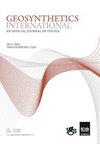Contribution of geosynthetic on the shear strength of geosynthetic encased stone columns
IF 3.3
2区 工程技术
Q2 ENGINEERING, GEOLOGICAL
引用次数: 4
Abstract
This paper presents a numerical study to evaluate the contribution of geosynthetic on the shear strength of geosynthetic encased stone column (GESC) under direct shear loading conditions. The backfill soil was characterized using the linearly elastic-plastic Mohr-Coulomb model. The geosynthetic encasement was simulated using linearly elastic liner elements. The interaction between the geosynthetic encasement and soils on both sides was modeled through two interfaces. The three-dimensional numerical model was validated using experimental data from direct shear tests of GESC models. The shear stress-strain response and the development of longitudinal and circumferential strains of GESC during the shear process were first discussed, and then a parametric study was conducted to investigate the effects of various design parameters on the shear strength of GESC and the contribution of geosynthetic. Results indicate that the shear resistance provided by the geosynthetic encasement develops slowly, which depends on the mobilization of tensile strains. At the failure condition, the longitudinal strains are larger than the circumferential strains, which indicates that the longitudinal tensile rupture is more critical for GESC under shear loading. The vertical stress, geosynthetic encasement stiffness, stone column diameter and spacing have the most important influences on the shear strength contribution of geosynthetic encasement.土工合成材料对土工合成围护石柱抗剪强度的贡献
本文对直接剪切荷载条件下,土工合成材料对土工合成包石柱抗剪强度的贡献进行了数值研究。采用线弹塑性莫尔-库仑模型对回填土进行了表征。采用线弹性线性单元模拟了土工合成材料的包裹体。通过两个界面模拟了土工合成围护体与两侧土体的相互作用。利用GESC模型的直剪试验数据对三维数值模型进行了验证。首先讨论了GESC在剪切过程中的剪切应力-应变响应以及纵向和周向应变的发展,然后进行了参数化研究,探讨了不同设计参数对GESC抗剪强度的影响以及土工合成材料的贡献。结果表明,土工合成包壳提供的抗剪能力发展缓慢,主要依赖于拉应变的动员。在破坏状态下,纵向应变大于周向应变,表明剪切荷载作用下纵向拉伸破坏对GESC更为关键。竖向应力、土工合成围护体刚度、石柱直径和间距对围护体抗剪强度贡献影响最大。
本文章由计算机程序翻译,如有差异,请以英文原文为准。
求助全文
约1分钟内获得全文
求助全文
来源期刊

Geosynthetics International
ENGINEERING, GEOLOGICAL-GEOSCIENCES, MULTIDISCIPLINARY
CiteScore
6.90
自引率
20.00%
发文量
91
审稿时长
>12 weeks
期刊介绍:
An online only, rapid publication journal, Geosynthetics International – an official journal of the International Geosynthetics Society (IGS) – publishes the best information on current geosynthetics technology in research, design innovation, new materials and construction practice.
Topics covered
The whole of geosynthetic materials (including natural fibre products) such as research, behaviour, performance analysis, testing, design, construction methods, case histories and field experience. Geosynthetics International is received by all members of the IGS as part of their membership, and is published in e-only format six times a year.
 求助内容:
求助内容: 应助结果提醒方式:
应助结果提醒方式:


